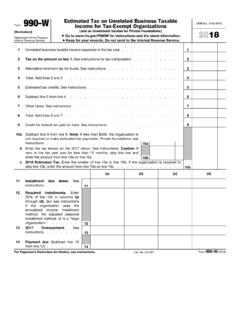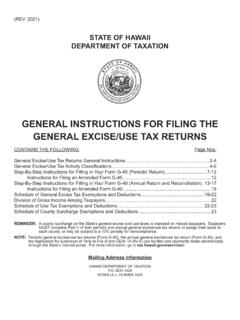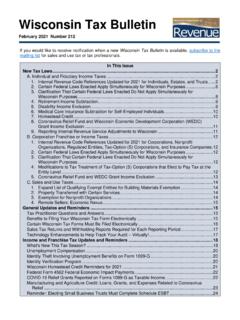Transcription of Coming to America - Andersen Tax
1 Coming to America Tax Planning for Foreign-Owned Operations By Len Schneidman Andersen Tax LLC, June 2017 Andersen Tax LLC, | Tax Planning for Foreign-Owned Operations 1 Table of Contents Introduction .. 2 Tax Checklist for Foreign-Owned Operations .. 2 Typical Life Cycle of Foreign-Owned Operations .. 3 Form of Organization .. 3 Subsidiary .. 4 Branch .. 4 Partnership or LLC .. 4 Capitalization .. 5 Case Study Manufacturing in .. 6 Personnel .. 6 Repatriation of Profits (Including Royalties and Inbound Sales) .. 7 Case Study Sale and Distribution in 8 Exit Strategies .. 8 Andersen Tax LLC, | Tax Planning for Foreign-Owned Operations 2 Tax Planning for Foreign-Owned Operations Introduction This Guide is intended to outline some of the key tax issues that should be considered in establishing a foreign-owned business enterprise in the United States.
2 Of course, foreign is a relative notion. Used herein, it means a business entity (assumedly a corporation) owned by shareholders. As can be seen from the Tax Checklist for Foreign-Owned Operations, the issues range from organizational and operational to repatriation of earnings and exit strategies. There are, of course, a number of home country legal and tax issues that must also be considered in structuring an outbound investment ( , from a jurisdiction into the United States). Tax Checklist for Foreign-Owned Operations ORGANIZATIONAL STRUCTURE Non-presence Use of agents or distributors Choice of entity Branch Subsidiary Joint Venture Partnerships Limited Liability Company (LLC) Capitalization Debt Equity Common stock Preferred stock OPERATIONAL STRUCTURE Taxation of enterprise Federal State and local Taxation of employees citizens Foreign nationals REPATRIATION OF EARNINGS Dividends Withholding (effect of tax treaties) Interest Deductibility Withholding (effect of tax treaties) Sales Taxability to foreign seller Arms-length standard (related party) Royalties Deductibility Arm s-length standard (related party) Withholding (effect of tax treaties) EXIT STRATEGIES Liquidation Trade sale Asset vs.
3 Stock sale Sale of real property Initial public offering Andersen Tax LLC, | Tax Planning for Foreign-Owned Operations 3 Typical Life Cycle of Foreign-Owned Operations It should be noted that the tax issues increase in importance as the enterprise advances through the typical life cycle of a foreign-owned operation. STAGE LEGAL OPERATIONAL CHARACTERISTICS TAX CHARACTERISTICS Seed Use of unrelated third parties ( , distributors; no (or very limited) physical presence; no additional business structure None Start-up Physical presence; limited functions performed ( , ancillary and preparatory activities); form of business structure ( , branch or subsidiary) not significant Certain activities may be conducted in without giving rise to taxable presence ( , permanent establishment); payroll and employee tax issues appear.)
4 Growth Increased physical presence; activities directly connected to the business conducted ( , sales solicitation and customer support; research and development); tax consequences of choice of entity become important. Nature and amount of activities drive operational tax results; increased payroll and employee tax issues. Expansion Distribution or other significant elements of business conducted by operation; employee headcount rises. Increased activities typically give rise to increase in amount of tax; need for professional tax planning becomes apparent; continued employee tax issues. Mature Manufacturing or other production activities commenced; headcount rises. Need for operational tax planning increases ( , intellectual property migration). This Guide focuses on the organizational and operational tax questions to be considered by a hypothetical foreign-owned enterprise that intends to conduct business activities in the United States.
5 The critical tax issues relate to the taxation of the enterprise, its shareholders and its employees, although, at times, these considerations may be unrelated. This Guide assumes that the foreign owner is a company, treated for tax purposes as a corporation that invests directly in the and, under the terms of the applicable United States Income Tax Treaty (Treaty), is a resident of the foreign jurisdiction that satisfies the Limitation on Benefits article of the Treaty. Therefore, the foreign owner is eligible for the benefits available under the Treaty. Form of Organization There are several ways in which a foreign company can operate a business in the The exact legal form the operation will take often depends on the nature of the business and the scale of the intended operation. Andersen Tax LLC, | Tax Planning for Foreign-Owned Operations 4 The possible choices for the organizational form of the operation include: Subsidiary Branch Partnership or Limited Liability Company (LLC) Subsidiary.
6 The formation of a corporate subsidiary is generally not a taxable event. However, the corporate subsidiary would have to pay federal and state income taxes on its taxable income. Dividends paid by the wholly owned subsidiary are subject to a withholding tax which under the Treaty is reduced from the statutory rate of 30% to a lower rate, typically 10% but in some cases to either zero or 5%. Dividends paid from the subsidiary to its foreign parent are not deductible for corporate income tax purposes. Operating through a separately incorporated subsidiary generally avoids any engagement in business by the foreign parent, provided that the subsidiary does not act as an agent for the foreign parent. As a general matter, the mere fact that a parent company owns a subsidiary does not, in itself, create a permanent establishment of the parent.
7 It is crucial, however, to avoid any attribution of the subsidiary s activities as, for example, an agent of its parent. Thus, if the subsidiary is acting as a commission agent for the sale of its foreign parent s goods, it is important that the subsidiary, which will likely be considered a dependent agent, does not have the ability to contractually bind the foreign parent. Transactions between the foreign parent and its subsidiary are generally governed by the arm s-length standard imposed by the tax law. The tax law prevents companies from shifting income in an abusive fashion by giving Internal Revenue Service authority to reallocate income and deductions among commonly controlled companies if it determines that such action is necessary to prevent evasion of taxes or to clearly reflect income. Branch.
8 Branches are easy to establish and administer and are simply an extension of the company s home office. When the foreign company operates through a branch, the company is taxable in the on the income effectively connected with its trade or business . Under the Treaty, only those profits attributable to a permanent establishment of the foreign company are taxable business profits in the A critical tax question thus becomes determining the amount of income that is properly attributable to the branch under the Treaty. This amount is taxable at rates applicable to corporations which, currently, are a maximum of 35% for federal tax purposes. Most states in the also impose tax on the income of a corporation that has some form of activities within that state. In addition to subjecting the company to regular corporate income tax, operating the business through a branch triggers the possible application of a branch profits tax.
9 The branch profits tax essentially replicates the 30% withholding tax on dividends payable by a subsidiary to its foreign parent company. The tax base for the branch profits tax generally includes after-tax earnings and profits that are effectively connected with the foreign corporation s trade or business (effectively connected earnings and profits, or ECEP) to the extent that such ECEP is not reinvested in the trade or business by the close of the taxable year or is sent home in a later taxable year. Tax treaties may limit the effect of the branch profits tax, more or less in the same way as withholding taxes on dividends from a domestic subsidiary are limited. Partnership or LLC. Operating through a partnership (either domestic or foreign) or an LLC, which is generally taxed as a partnership, engages its partners in the trade or business conducted by the partnership or LLC.
10 Thus, while the partnership or LLC is not subject to tax, the foreign partner or LLC member is taxable on its allocable share of the partnership or LLC s effectively connected income. In addition, if the foreign partner is a corporation, the activities of the partnership constitute a branch of Andersen Tax LLC, | Tax Planning for Foreign-Owned Operations 5 the foreign corporation triggering the application of the branch profits tax, as described previously. Failure of the foreign partner or member to timely file a tax return will lead to the loss of otherwise available tax deductions producing, in effect, a tax on gross receipts. Capitalization Another choice to be made by the foreign company is whether to capitalize the venture with debt, equity or a combination of the two. From a tax standpoint, it is generally better to fund direct investment via debt rather than equity.



